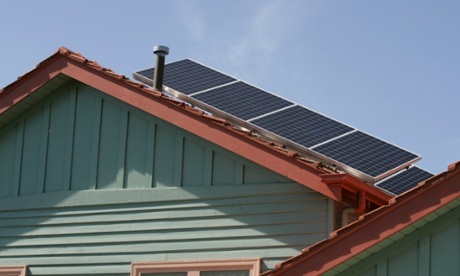Futures Forum: Solar Plan for Sidmouth: second application fails
... the South-West now generates enough renewable electricity - including solar - to power over one quarter of all homes in the region.
Solar growth pushes south west to 1.2GW of renewable capacity
 Around 270MW of new PV capacity was added to the south west in the last 12 months
Around 270MW of new PV capacity was added to the south west in the last 12 months
The south west of England generates enough renewable electricity to power more than one quarter of all homes in the region, according to a report published by Regen SW.
The South West Renewable Energy Progress Report shows that renewable capacity in the south west has increased by 37% over the last 12 months to a total of nearly 1.2GW.
The largest area of growth in the region has been through the deployment of solar PV which represented 270MW of new capacity. Of that PV capacity, more than 60% is attributed to large-scale solar farm developments.
Smaller scale renewable installations have also proved extremely popular in the region with 21% of projects supported by the feed-in tariff and 12% supported by the renewable heat incentive.
Commenting on the report, Merlin Hyman, chief executive of Regen SW said: "This year's progress report is encouraging. However, it should be just the start. With 70% of all investment in energy globally predicted to be in renewables, our success in this market is critical. By meeting our renewables targets we could create 34,000 high-value jobs, become less reliant on uncertain oversees supplied fossil fuels, and use our local renewable energy resources to generate income and fuel security for local communities."
The report identifies a number of barriers that are continuing to constrain the deployment of renewables, namely grid capacity, local planning rules and community engagement and strategy.
Hyman added: "A key conclusion of our analysis is that we need to take more responsibility locally for making the most of the excellent renewable energy resources we have: putting local communities at the heart of developments; and supporting local companies to compete for work."
Solar growth pushes south west to 1.2GW of renewable capacity | Solar Power Portal
An article in this week's Guardian makes the point:
Solar has won. Even if coal were free to burn, power stations couldn't compete
As early as 2018, solar could be economically viable to power big cities. By 2040 over half of all electricity may be generated in the same place it's used. Centralised, coal-fired power is over

Last week, for the first time in memory, the wholesale price of electricity in Queensland fell into negative territory – in the middle of the day.
For several days the price, normally around $40-$50 a megawatt hour, hovered in and around zero. Prices were deflated throughout the week, largely because of the influence of one of the newest, biggest power stations in the state – rooftop solar.
“Negative pricing” moves, as they are known, are not uncommon. But they are only supposed to happen at night, when most of the population is mostly asleep, demand is down, and operators of coal fired generators are reluctant to switch off. So they pay others to pick up their output.
That's not supposed to happen at lunchtime. Daytime prices are supposed to reflect higher demand, when people are awake, office building are in use, factories are in production. That's when fossil fuel generators would normally be making most of their money.
The influx of rooftop solar has turned this model on its head. There is 1,100MW of it on more than 350,000 buildings in Queensland alone (3,400MW on 1.2m buildings across the country). It is producing electricity just at the time that coal generators used to make hay (while the sun shines).
The impact has been so profound, and wholesale prices pushed down so low, that few coal generators in Australia made a profit last year. Hardly any are making a profit this year. State-owned generators like Stanwell are specifically blaming rooftop solar.
Tony Abbott, the prime minister, likes to say that Australia is a land of cheap energy and he’s half right. It doesn’t cost much to shovel a tonne of coal into a boiler and generate steam and put that into a turbine to generate electricity.
The problem for Australian consumers (and voters) comes in the cost of delivery of those electrons – through the transmission and distribution networks, and from retail costs and taxes.
This is the cost which is driving households to take up rooftop solar, in such proportions that the level of rooftop solar is forecast by thegovernment’s own modellers, and by private groups such as Bloomberg New Energy Finance, to rise sixfold over the next decade. Households are tipped to spend up to $30bn on rooftop modules.
Last week, the WA Independent market Operator forecast that 75% of detached and semi detached dwellings, and 90% of commercial businesses could have rooftop solar by 2023/24.
The impact on Queensland’s markets last week is one of the reasons why utilities, generators and electricity retailers in particular want to slow down the rollout of solar.
The gyrations of wholesale power prices are rarely reflected in consumer power bills. But let’s imagine that the wholesale price of electricity fell to zero and stayed there, and that the benefits were passed on to consumers. In effect, that coal-fired energy suddenly became free. Could it then compete with rooftop solar?
The answer is no. Just the network charges and the retailer charges alone add up to more than 19c/kWh, according to estimates by the Australian energy market commissioner. According to industry estimates, solar ranges from 12c/kWh to 18c/kWh, depending on solar resources of the area, Those costs are forecast to come down even further, to around 10c/kWh and lower.
Coal, of course, will never be free. And the rapid uptake of rooftop solar – dubbed the democratisation of energy – is raising the biggest challenge to the centralised model of generation since electricity systems were established more than a century ago.
Network operators in Queensland, realising the pent up demand for rooftop solar, are now allowing customers to install as much as they want, on the condition that they don’t export surplus electricity back to the grid.
Households and businesses have little incentive to export excess power. They don't get paid much for it anyway. Ergon Energy admits that this will likely encourage households to install battery storage.
The next step, of course, is for those households and businesses to disconnect entirely from the grid. In remote and regional areas, that might make sense, because the cost of delivery is expensive and in states such as Queensland and WA is massively cross-subsidised by city consumers.
The truly scary prospect for coal generators, however, is that this equation will become economically viable in the big cities. Investment bank UBS says this could happen as early as 2018.
The CSIRO, in its Future Grid report, says that more than half of electricity by 2040 may be generated, and stored, by “prosumers” at the point of consumption. But they warn that unless the incumbent utilitiescan adapt their business models to embrace this change, then 40% of consumers will quit the grid.
Even if the network operators and retailers do learn how to compete – from telecommunication companies, data and software specialists like Google and Apple, and energy management experts – it is not clear how centralised, fossil-fuel generation can adapt. In an energy democracy, even free coal has no value.
Solar has won. Even if coal were free to burn, power stations couldn't compete | Giles Parkinson | Comment is free | theguardian.com
In Australia:
Solar revolution drives negative electricity prices in Australia - 07 Jul 2014 - News from BusinessGreen
In India:
How to Effectively Modernize Rural India Using Solar Power | Energy Digital
In Scotland:
Don’t pull plug on funding for solar power schemes - The Scotsman
.
.
.


No comments:
Post a Comment